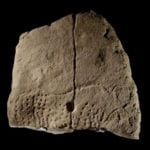 Mysteries
Mysteries  Mysteries
Mysteries  History
History 10 Surprising Stories About the Texas Rangers
 Humans
Humans 10 Philosophers Who Were Driven Mad by Their Own Theories
 Miscellaneous
Miscellaneous 10 Video-Game-Worthy Weapons and Armors from History
 Weird Stuff
Weird Stuff 10 Psychics Who Accurately Predicted Wartime Events
 The Arts
The Arts 10 Pieces of Art Inspired by a Broken Heart
 Health
Health 10 Science Fiction-Sounding New Medical Treatments
 History
History 10 Surprising Facts About the Father of Submarine Warfare
 Space
Space Ten Astonishing New Insights into Alien Worlds
 Weird Stuff
Weird Stuff 10 Bizarre Summer Solstice Rituals Still Practiced Today
 Mysteries
Mysteries Top 10 Haunting Facts About the Ghost Ship MV Alta
 History
History 10 Surprising Stories About the Texas Rangers
 Humans
Humans 10 Philosophers Who Were Driven Mad by Their Own Theories
Who's Behind Listverse?

Jamie Frater
Head Editor
Jamie founded Listverse due to an insatiable desire to share fascinating, obscure, and bizarre facts. He has been a guest speaker on numerous national radio and television stations and is a five time published author.
More About Us Miscellaneous
Miscellaneous 10 Video-Game-Worthy Weapons and Armors from History
 Weird Stuff
Weird Stuff 10 Psychics Who Accurately Predicted Wartime Events
 The Arts
The Arts 10 Pieces of Art Inspired by a Broken Heart
 Health
Health 10 Science Fiction-Sounding New Medical Treatments
 History
History 10 Surprising Facts About the Father of Submarine Warfare
 Space
Space Ten Astonishing New Insights into Alien Worlds
 Weird Stuff
Weird Stuff 10 Bizarre Summer Solstice Rituals Still Practiced Today
10 Remarkable Archaeological Finds In Swamps
Swamps aren’t just for Hollywood anacondas. They’re perfect history pockets. Their general inaccessibility allows artifacts, bodies, and even cities to await discovery without being damaged or looted. The physical conditions of marshlands can sometimes slow down deterioration, taking snapshots of the past that would otherwise have been lost.
10Swamp Ghost

Months after the Pearl Harbor attack in 1941, US bombers raided the Japanese at Simpson Harbor, Papua New Guinea. One plane made a second run after its bomb bay malfunctioned. Even though it worked the second time, a hot fight ensued between her crew and the enemy. The Flying Fortress managed to not explode in a spectacular fashion, but she never made it back to base. Badly whipped, she belly landed in a deep swamp.
Her crew stumbled to safety a few days later, bringing with them a tale of survival and a fresh dose of malaria. The war bird was only rediscovered in 1972, and its haunting appearance quickly earned her the name “Swamp Ghost.” Roughly three more decades would pass before conservation efforts freed the bomber in 2006. Today, Swamp Ghost enjoys a much better home at the Pacific Aviation Museum Pearl Harbor.
9The Hidden Community

The Great Dismal Swamp of Virginia and North Carolina was once runaway central. Fleeing Native Americans, wanted whites, and escaped slaves saw freedom inside the near-inaccessible environment. They received it for 10 generations. At one point, they numbered in their thousands. Then the elusive inhabitants of the swamp just disappeared.
Artifacts show they were self-sufficient and innovative, building cabins, weapons and tools, even clay pipes. They honored chiefs and followed an Africanized religion. One Dismal Swamp maroon, called Charlie, was later tracked down in Canada. He added that labor was communal and described how they made their own furniture and musical instruments. Why they vanished remains unclear. All archaeological evidence of this survivor community ends after the Civil War. One theory suggests that after the war, they blended back into society as free people.
8Ancient Floor Game

A swamp in Mexico holds an artificial island that is 5,000 years old. Mostly made of discarded clam shells, it grew to such a size that the fisher folk who created it started using it as a food processing station. To prevent the shells from cutting their feet to ribbons, they laid clay floors. Holes in the platforms fit the pattern of wooden racks, perhaps used to dry fish.
The site of Tlacuachero also has other head-scratching holes nobody can fully explain. These oddities are arranged in ovals, are smaller, and dent specific areas of the floors. Decorated clay disks found at Tlacuachero hint that the workers could have played some sort of floor board game. If true, it could be the oldest clue to how the ancients amused themselves in the Americas.
7The Windover Cemetery

In 1982, a peat pond in Florida revealed 168 bodies. They weren’t freakishly preserved like other bog corpses, but about half were found to still have their brains. They’re old. The Windover site was used by a hunter-gatherer community to bury their dead 3,500 years before the Pyramids.
The discovery clarified a few misconceptions about prehistoric people, if only about this bunch. Finely woven shrouds proved they weren’t figures running around in crude animal skins. Some walked this Earth for 70-plus years, and their tools were also incredibly sophisticated. They ate well, didn’t move around like hunter-gatherers usually did, and (unlike most ancient cemeteries) the Windover group had little evidence of violent deaths. If you wanted peace, plenty, and a ripe old age thousands of years ago, this was apparently the place to be.
6Houses On Stilts

Once upon a time, a village of stilt homes perched above water until fire destroyed it. After the settlement collapsed into the river below, it became frozen in time for 3,000 years. When rediscovered in the East Anglian Fens, the site was heralded as historic. Not only are the roundhouses the best preserved Bronze Age homes in Britain, but archaeologists are getting a good look at what their domestic life looked like—and it’s not what they thought.
The wooden huts yielded goods bearing a sophistication never before credited to this era: rich textiles, intricate jewelry, crockery, and a carpentry excellence that included a timber palisade around the houses. Remarkably, even the footprints of the prehistoric villagers remained preserved at the site.
5The Bridge Battle

In a zombie-movie moment, a human arm was found sticking from a riverbank. Soon, more human remains were unearthed in the Tollense Valley, Germany. Their wounds and numbers were horrifying. At the 10 percent mark of the investigation, 130 skeletons were already dug out of the marshy soil. Archaeologists realized that they were standing on an epic battlefield.
Thousands took up arms, and the slain changed the story about Europe’s Bronze Age men. Most researchers favored the idea that they were peaceful and focused on trading. However, this battle unearthed professional fighters and warfare on a scale never before seen in the area. The Tollense skeletons may even be the earliest example of direct conflict between warriors with weapons. The deadly confrontation probably sparked when both sides wanted control of the river’s bridge where the fighting started.
4Istanbul’s True Age

Archaeologists were delighted to discover 30 ships from the Byzantine era in Istanbul. During excavations, they stumbled on an even greater treasure: the city’s real age. At the heart of Istanbul, an ancient swamp revealed a grave that knocked its age back by a whopping 6,000 years.
Previously, the history books pinned Istanbul’s beginnings at around 700 BC. What appeared to be a family burial, two adults, and two kids, dated back to the Neolithic era when people first started to live in permanent locations. Traces of houses and tools nearby proved that there was a settlement, one that was almost certainly the earliest roots of the great Turkish city.
3The Fallen Russians

In 1983, Ilya Prokoviev found boots protruding from a swamp. What turned out to be an accidental discovery of a fallen World War II Russian soldier became a lifelong passion for Prokoviev, a former army officer himself. Together with volunteers, he scours known battlefields for his comrades—four million of them who are still considered missing in action on the Eastern Front. They don’t have to look very hard. The dead are everywhere, sometimes only covered by leaves.
Despite hardships, the diggers are committed. Some have been killed by explosives. Others cannot forget the mass graves that they have seen. All race against looters who strip bodies of their valuables and dignity. But thanks to their ongoing efforts, half a million soldiers have been returned to their families for burial.
2Paestum

During a relaxing swamp stroll, it might come as a surprise to see a huge Greek temple–especially in the middle of mosquito-infested nowhere. Imagine finding three together, all remarkably intact.
This is the last footprint of Paestum, a settlement that once thrived in the south of Naples. Dedicated to the goddesses Hera and Athena, they were constructed in the sixth and fifth centuries BC by the Greeks. The sacred sites were the only buildings to survive when the Romans destroyed the colony of Poseidonia and replaced it with their own city, Paestum. The next few centuries saw Paestum slide into obscurity and malarial marshes before being abandoned.
Rediscovered in the 18th century, the temples changed architectural history. At first considered primitive against later Roman styles, scholars now promote Paestum as evidence that the Greek Dorian style conceived classical Roman architecture.
1Atlantis In Spain

Atlantis has been found everywhere, so why not in a marsh, too?
In yet another claim that the mythical city is real, a team of US archaeologists and geologists point to southern Spain. Their high tech surveillance show that something is definitely there. Submerged in the marshlands of the Dona Ana Park, it’s big and multi-ringed just like the ancient metropolis. It’s not just the shape of the strange formation that makes this particular Atlantis more credible to the researchers. About 150 miles away, they found what they called “memorial cities” and believe the ruins are remnants of Atlantean hands who built them in the image of their lost home.








